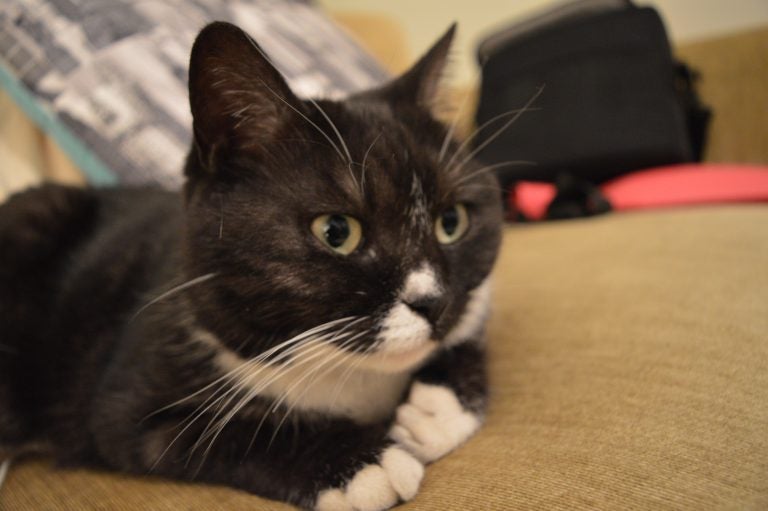Should your cat get to go outside?
Keeping Ahab the cat cooped up seemed to crush her spirit and hunting instincts, so owner Liz Tung consulted with experts to weigh the cost of feline freedom.
Listen 8:17
The author's cat, Ahab — who once left the disembodied heart and beak of a sparrow buried under her owners' laundry. (Liz Tung/WHYY)
My introduction to the indoor-outdoor cat debate began during a visit to the veterinarian almost two years ago.
I’d brought my cat, Ahab, in for her annual checkup. She was a 4-year-old tuxedo cat, petite and fluffy, with a round face and lemur-like eyes. She’d always been healthy, but that day I was asking for something beyond the usual boosters — whatever shots she’d need to go outside.
It wouldn’t be Ahab’s first experience with the outdoors. I’d adopted her while living in China, where indoor cats are the exception rather than the rule. As a kitten, she’d taken to the outdoors like a fish to water. To my chagrin, she was an excellent hunter — when she was just a couple months old, I once found her on my patio, trying to chew through the head of a gecko. Beyond that, she was good at taking care of herself — she never got in fights, never got hurt, and almost always came when called.
“I’d definitely say she’s street smart,” my husband said. His name is David Wilson, but everyone calls him Woolly. “She’s always wary of her surroundings — she understands the terrain.”
But Ahab’s days outside came to an end when we moved back to the U.S. in 2016. We were living in a small Brooklyn apartment that made it impossible for Ahab to go outside. Soon, her behavior changed.
“I really started to notice because she couldn’t go outside, she was a little angsty,” Woolly remembered. “She bit me once, and she’d never really done that before. She’d never been aggressive or anything, and I think she was just bored; she just lacked the stimulation.”
So when we moved into a small row home with a yard, we figured this was our chance to let her back outdoors. Our vet, on the other hand, disagreed.
“I can give her the shots if you want,” he said. “But if you value your cat, you won’t let her outside.”
His fear, he said, stemmed from the many threats that face outdoor cats: fights with other cats, kidnapping by humans and, of course, cars.
On a side note: cats can decimate wildlife, and that’s something bird lovers can get pretty mad about.
Back at home, I started searching for advice on the topic. Most animal welfare groups, from the Humane Society to the SPCA, agreed: cats should stay indoors, both for their welfare and that of local wildlife.
For awhile, we kept Ahab indoors, but even with daily playing — more stimulation — it seemed like her mood worsened.
“She’s a little life form, and we know what happens to people when they’re in prison — it’s really not good for your mental state,” Woolly said. “It’s always a toss-up between keeping her safe and not letting her outside, but having a cat that’s depressed and unhappy and might act out a bit, and having a cat that has the freedom to enjoy life.”
So we decided to consult some real experts, starting with self-proclaimed “cat daddy” — and host of the Animal Planet show, “My Cat from Hell” — Jackson Galaxy.
“I feel like it’s a parenting choice,” Galaxy said. “Is there a part of your cat’s life that is not fulfilled by being outside? The answer is yes. But on the other hand, there’s the straight-up fact that if you just let them just go outdoors, that will significantly shorten their lives, period.”
Still, Galaxy, who’s a cat behaviorist, says depression and anxiety are real risks for an indoor cat that isn’t getting its needs adequately met.
“I think that depression and anxiety for a prey animal, like a cat, comes from not having the outlet of what I call the raw cat,” Galaxy said. “Raw cat” is his term for a feline’s hunting instinct.
“From a DNA standpoint, they are programmed to wake up and catch, kill and eat,” Galaxy said. “As a human, if you knew you were on this planet to do one thing, and that one thing you were not permitted to do, you would also be anxious and depressed.”
Cat behaviorist Pam Johnson-Bennett also points to the imperative of the prey drive.
“They call it the seeking circuit — it releases the dopamine, it makes them feel good, so it’s a part of who they are,” she said. “And you can provide that indoors. The dopamine will still be released if you’re dangling a toy and playing with your cat. It doesn’t have to be a real mouse.”
The problem, according to cat welfare researcher Candace Croney, is that a lot of cats don’t get that kind of daily stimulation.
“We don’t necessarily provide them as much engagement or as many opportunities for new mentally stimulating ways to engage with their home environments — especially when they’re kept indoors,” Croney said. “Because we oftentimes have these preconceptions that they don’t really need that stuff. They can just take care of themselves.”
Croney says that’s why a high proportion of indoor cats end up under-stimulated, overweight, and, often, depressed.
“There is no blanket answer for what’s best for the cat,” Croney said. “It really is just a function of what you’re looking for — what your definition of good welfare is.”
Croney teaches as Purdue University’s veterinary school and each year she poses that question to her ethics class.
“Which cat has a better quality of life,” she asks. “The live-free, diehard cat, or the long-lived, well-protected cat that doesn’t have quite as much going on in its life?”
Croney says that despite her students’ orientation toward protecting cats’ physical health, most of them choose the outdoor cat.
“We’re consistently sending the message that we want them to have a good, long life,” Croney said. “But the interesting part of that sentence is, what ‘good’ looks like to people. So it’s not just longevity that seems to matter — it’s what the quality or the richness of that life looks like.”
That doesn’t mean Croney is an advocate for letting cats roam outdoors. She, Jackson Galaxy, and Pam Johnson-Bennett, all keep their cats indoors. The key, Galaxy said, is making sure to provide enough playtime and environmental enrichment to keep your indoor cat happy.
“There is no definitive way to gauge the depressed factor,” he said. “My challenge to everybody is this: gauge that factor after you’ve done everything in your power to replace the stimuli, to provide for them the stimulation that they need. Because it is definitely a harder parenting choice to do the work, you know, as opposed to opening the door.”
For now … our cat, Ahab, still gets to go outside.
We’re still weighing all the experts’ advice against Croney’s final words:.
“The cat’s personality should dictate whether or not you choose to let that cat have some level of safe, protected access to the outdoors,” she said. “There are many street-smart cats, and there are many who are all book smarts and should really be protected. It’s just — know your cat, know what’s safe for your cat, and what your cat prefers — and try to offer those things. And her welfare is probably going to be better protected than if you don’t.”
WHYY is your source for fact-based, in-depth journalism and information. As a nonprofit organization, we rely on financial support from readers like you. Please give today.






